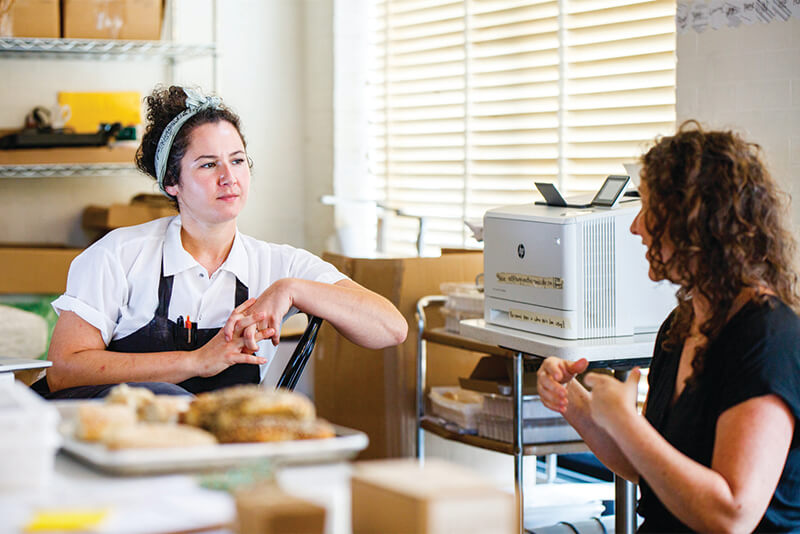Phase VII Topics

You might be thinking…
Tenant improvements are nearing completion, yet I have a million things to do — where should I focus my efforts?
In the final weeks and days leading up to your opening, there will be many things you will need to get done. Focus your limited time on the tasks that are most critical to obtaining your final occupancy permits (health and safety items) and operating the business (hiring and training staff). While pre-opening marketing is important, spending the bulk of your time crafting the perfect social media post, but not enough time making sure your staff knows how to use your point of sale system, could result in challenges during your first few days of being open.


Terms to familiarize yourself with
Final Space Improvements + Fit Out
Install your Furniture, Fixtures & Equipment (FF&E) not included in your contractor’s scope of work.
Install your Furniture, Fixtures & Equipment (FF&E) not included in your contractor’s scope of work.
This includes everything considered elements of the interior design — tables and chairs and other furniture; lighting fixtures; artwork and decor; shelving and display cases; miscellaneous kitchen equipment, etc.
Note: You likely want to order your FF&E well in advance of this phase, as delivery and lead times for many items are very long.
Make a “punch list” for your contractor to complete before opening.
A punch list is simply a list of final and remaining tasks that still need to get done before a certain deadline. Ideally, the contractor can be reminded of the items on this list and simply “punch them out” (get them done) quickly. While they may seem small, finishing such tasks (like making sure a door isn’t swinging the wrong way, or the toilet paper holders are installed in the bathroom) will be important for a smoother opening day — and beyond.
Purchase smallwares and inventory.
Get your inventory stocked up by purchasing and preparing items like plates, cutlery, glassware, uniforms, etc.
Hiring + Training Staff


Begin advertising for open positions, recruiting candidates, interviewing, and hiring staff as early as possible.
You will want to leave time for training staff before opening for business.
Plan for a significant amount of turnover and carefully track all interested parties for future openings, even those that do not accept a job now or are not necessarily qualified for certain positions.
Marketing + Promotion
Website
- Your business needs a website. It does not have to be overly complicated and can certainly be a simple page with contact info, hours of operation, address, a few photos, and a list of services.
- Check out services like Squarespace.com that let you create simple, cost-effective websites.
Social Media
- What social platforms will you use to communicate your message? Who is your audience and where are they on social media — Instagram, Facebook, TikTok, Twitter, Yelp, etc.?
- Consider an editorial content calendar and social media scheduling platforms.
- What social platforms will you use to communicate your message? Who is your audience and where are they on social media — Instagram, Facebook, TikTok, Twitter, Yelp, etc.?
- Consider an editorial content calendar and social media scheduling platforms.
Photography
Take professional photos of your shop or restaurant highlighting key features — food, staff, interiors and exteriors, excited customers, etc.
Press
Reach out to local media publications with your story and details behind your opening. Most publications have “contact” and “staff” pages to find out where to send your release. Be sure to note what makes your business new and special (e.g., BIPOC-owned, original menu items, etc.)
Soft Opening
A “soft opening” period, anywhere from a few days to a week prior to your official opening, can help you and your employees ease into operations. During this time, you would open for business for limited hours, perhaps with limited service/offerings/ menu, to get your staff comfortable with routines and operations, learn how the space flows, and gather feedback from customers (who are often friends and family during soft opening periods). All the learnings and insights you gain from the practice period of a soft opening can help you adjust and tweak before your grand opening.
Some ways a soft opening can take form include:
Hosting a special Friends and Family event
Preview smaller sample menu (if restaurant) for a period of time
Directly ask for feedback from customers via a survey
Full Opening
- Once you have had your soft opening, it’s time to open for real. Swing open your doors, hang some balloons, and blast your opening on your social media platforms and website. This is when your business opens with full hours of operation. If feasible, offer your full menu and line of products and services.
- It is also important to maintain strong engagement with your staff, your project team, and the advisors who helped you reach this milestone. They will have plenty of valuable ways to help you during the first weeks and months of business.
- Be sure to perform an ongoing review of your budget in the early stages of your opening to make certain that you are on track. Make time to review your budget and forecast the months ahead.


Post-Opening


A list of things to do shortly after opening:
- Check in regularly with your landlord.
- Re-introduce yourself to your retail neighbor(s).
- Schedule regular check-ins with your key advisors.
- Find ways to collect data from your customers that will help inform your business strategy (survey, testimonials, reviews, web/social analytics).
- If you don’t already have one, find a mentor who can help provide guidance as you scale your business.


